Types of Yellow Beetles (With Pictures) – Identification Guide

Yellow beetles generally have brightly colored yellow or golden yellow bodies making them stand out in a landscape. Some varieties of yellow beetles have black stripes or patches, giving them an incredibly striking appearance. The most common kind of yellow beetle is the striped cucumber beetle (Acalymma vittatum). Other common beetles with yellow bodies include yellow ladybugs, the velvet beetle, and the black and yellow longhorn beetle.
Like all beetle species, yellow beetles are arthropods belonging to the order Coleoptera. This fact means that all varieties of yellow beetles have six legs, two antennae, and a body consisting of a head, thorax, and abdomen. Beetles also have two elytra — hardened wing cases that typically cover the wings entirely.
Yellow beetles are typically small insects divided into several families depending on their body shape and habitat. For example, yellow beetles can have rounded oval bodies like the spotted yellow cucumber beetle or yellow ladybug. Or they can have long, slender bodies like the yellow soldier beetles or longhorn beetles.
This article provides helpful tips and guidelines for identifying common yellow beetle types. In addition, descriptions and pictures of these small yellow insects will help you spot differences between various beetle species.
How to Identify Yellow Beetles
To identify a species of yellow beetle, look at its body shape, patterns on its wing cases, and type of antennae. For example, yellow beetles can be identified by their serrated, clubbed, or bead-like antennae. Also, note if the beetle has a rounded, oval body or a flattened, elongated one.
Other identifying features of beetles are their mandibles — chewing mouthparts on their head, the size and shape of their legs, and three body segments. So, for example, if the creepy crawly has four or eight legs, it cannot be a beetle.
Many people may refer to yellow beetles as yellow bugs. This is because the yellowish creatures can become a nuisance in yards or the home. However, yellow beetles aren’t bugs in the true sense of the word. A true bug is classified as an insect in the order Hemiptera. However, yellow beetles belong to the order Coleoptera.
Types of Yellow Beetles (With Pictures) – Identification
Let’s look at the identifying features of some of the most common yellow-bodied beetles you are likely to come across.
Striped Yellow Cucumber Beetle (Acalymma vittatum)
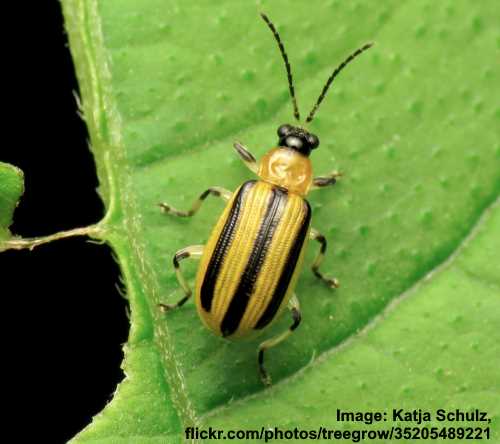
The striped yellow cucumber beetle is a destructive pest with 3 black stripes on its yellow body
The striped cucumber beetle is a small insect with bright yellow wing cases and three black stripes. The small beetle is identified by its yellow thorax, black head, and black thread-like antennae. The vibrantly-colored yellow and black beetle is easy to spot on green foliage.
The striped cucumber beetle measures 0.2” (5 mm) long and 0.05” (1.3 mm) wide, and it has an oval body. Pictures of the colorful striped beetles also show they have yellow and black legs.
The cucumber beetle gets its name because it feeds on cucumber foliage and other cucurbit plants. The highly destructive pest can do significant damage to cucumber leaves and flowers and even damage the fruit.
Yellow beetle identification
The characteristic features of the striped cucumber beetle are its bright yellow elytra with black stripes running longitudinally. The golden yellow and black bugs are common in spring and are a pest on cucurbit crops.
Spotted Yellow Cucumber Beetle (Diabrotica undecimpunctata)
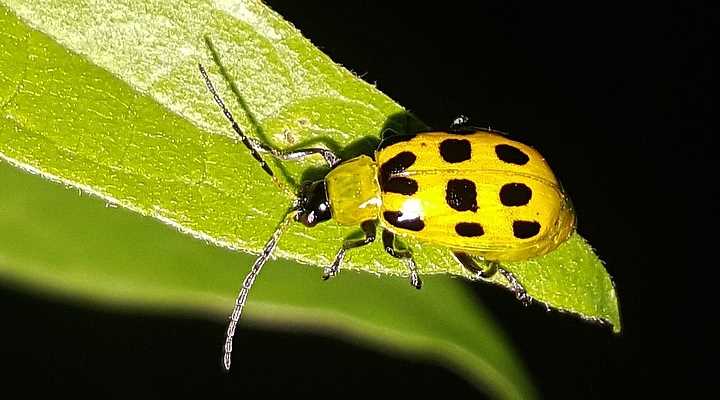
The spotted yellow cucumber beetle has black spots on its yellow wing covers
The yellow spotted cucumber beetle has a dull yellow, pear-shaped body with three rows of black spots on its elytra. The destructive yellow “bug” is also identified by its black legs, greenish thorax, black head, and long thread-like antennae. Like the striped cucumber beetle, this pesky yellow insect destroys cucurbit crops.
Spotted cucumber beetles measure 0.25” (6.4 mm) long with characteristic 12 black spots on their yellowish-green bodies.
These destructive yellow beetles destroy crops by defoliating plants, transmitting disease, and killing their roots.
Yellow beetle identification
The identifying marks of the spotted cucumber beetle are six spots on each bright yellow wing cover, a black head with two slender antennae, and a greenish thorax.
Black and Yellow Longhorn Beetle (Rutpela maculata)

The black and yellow longhorn beetle is identified by its elongated body with black dots and stripes on its yellow body
The brightly-colored yellow longhorn beetle is easily identifiable due to the black dots and stripes on its slender body. This large, colorful beetle has elytra that are primarily yellow for two-thirds of its length. There are two black bands at the beetle’s tail end.
The black-spotted yellow longhorn beetle gets its name from its long, arching antennae with alternating bands of black and yellow. Other characteristics of the beetle are its four dull orange forelegs and two black and orange-brown hind legs. Also, the yellow and black beetle has a black head, bulging eyes, and a black thorax.
The yellow longhorn beetle measures 0.5” to 0.78” (13 – 22 mm) long. Its wing covers are wider at the thorax and taper at the rear end.
Yellow beetle identification
The black and yellow longhorn beetle has bright yellow elytra with two stripes and several small black dots. It’s easy to identify due to its long legs and antennae.
Yellow Ladybug (Coccinellidae)
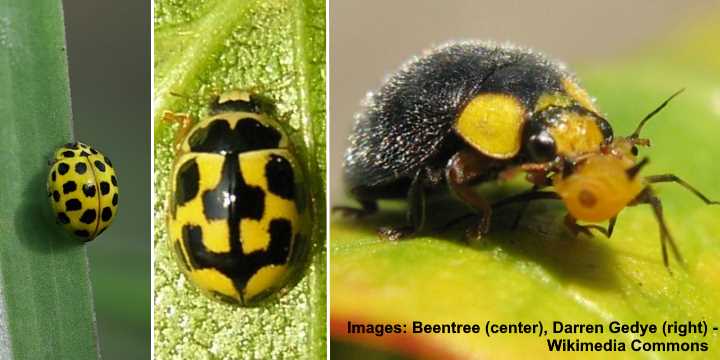
Yellow ladybugs. Left to right: the 22 spotted ladybug, 14 spotted ladybug and yellow shouldered ladybird with yellow aphid
Several species of ladybugs have bright yellow wing covers with black dots covering them. The tiny yellow beetles have dome-shaped bodies, six short black legs, spotted elytra, and a black head, sometimes with yellow spots. The small flying yellow beetles generally measure 0.03” to 0.7” (0.8 – 18 mm) long.
Although most people identify ladybugs as red beetles, yellow species are surprisingly common. The common names of many yellow ladybugs usually refer to the number of spots on their yellow backs.
Here are some examples of common ladybug species that are primarily yellow:
Twenty-two spotted ladybug (Psyllobora vigintiduopunctata): bright yellow with 22 black spots.
Fourteen spotted ladybug (Propylea quatuordecimpunctata): yellow and black lady beetle.
Yellow-shouldered ladybird (Apolinus lividigaster): primarily black with two yellow spots, and black and yellow head.
Yellow beetle identification
Also called lady beetles, yellow ladybugs are tiny beetles with a rounded, oval body and yellow and black markings on their backs.
Yellow-Bellied Beetle (Pachnoda flaviventris)
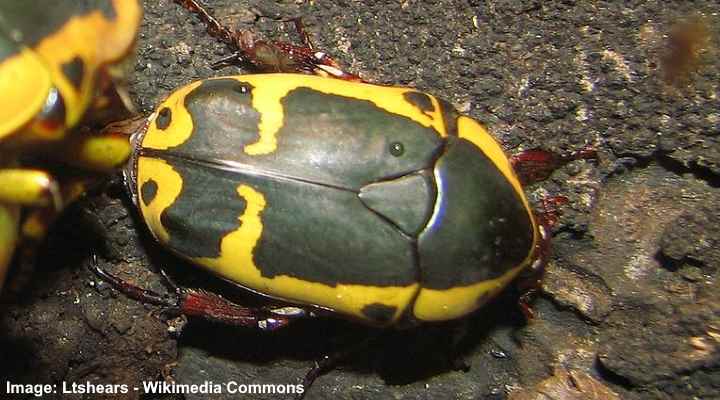
The yellow-bellied beetle has an oval yellow and black body with brown head and legs
Also called the garden fruit chafer, this black and yellow beetle has a broad, oval body, mostly black with yellow margins and several bright yellow spots. The relatively large beetle has a small brown head, clubbed antennae, and stout brown legs. Some species of this beetle have red elytra.
The large yellow flying beetle measures 0.79” to 2” (20 – 25 mm) long and has a flattened body. However, to see its vibrant yellow colors, you must turn the beetle over — hence the common name yellow-bellied beetle.
Yellow beetle identification
The brightly patterned yellow-bellied beetle has yellow elytra with large black patterning on them. Dark brown antennae, head, and legs contrast with its colorful body.
Flower Longhorn Beetle (Typocerus sparsus)

The black and yellow flower longhorn beetle has elongated body with long brown legs
The flower longhorn beetle is a native beetle to North America with black and yellow markings. The slender beetle has elongated wing cases that taper to the rear. These have several bright yellow and black bands, making the beetle resemble a wasp. In addition, the longhorn beetle has a black head, long rusty brown legs, and brown antennae.
This yellow and black longhorn beetle measures around 0.43” (11 mm) long. Its easily identifiable feature is the long, hooked segmented antennae. In relation to its body, the beetle also has long legs.
Yellow beetle identification
The flower longhorn beetle is identified by its broad yellow and black stripes traversing its elytra. The two principal identifying features are its long, segmented antennae curved at the end and two long hind legs.
Yellow and Black Fiddler Beetle (Eupoecila australasiae)
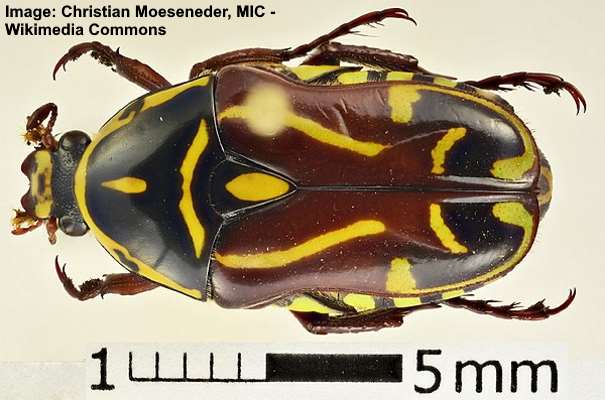
The fiddler beetle has oval flattened black and brown body with yellow markings and short legs
The fiddler beetle is a type of scarab beetle with colorful yellow and black wing cases. The easy-to-identify beetle has recognizable violin-like patterns on its back. Other characteristics of these striking beetles are their small head and short brown-reddish legs. The fiddler beetle measures 0.6” to 0.8” (15 – 20 mm).
Also called the rose chafer beetle, the large, flattened brown and yellow or black and yellow beetles are strong flyers. They typically feed on flower nectar and play a role in pollinating flowers.
Depending on the species, the fiddler beetle can have brown elytra with bright green patterns.
Yellow beetle identification
The identifying features of the fiddler beetle are its dark brown wing covers with bright yellow patterns in the shape of a violin.
Eurasian Bee Beetle (Trichius fasciatus)

The Eurasian bee beetle is identified by its pale yellow body with black patches and short antennae
The Eurasian bee beetle is one of the most unusual yellow beetles because of its resemblance to bumblebees. The broad beetle has pale yellow wing covers with three black patches and black edges. In addition, pale hairs surrounding the elytra give the beetle a fuzzy appearance.
This yellow beetle is unlike other beetles on this list. Apart from its creamy-yellow and black back, the insect has a large round thorax and small brown furry head. In addition, its antennae are challenging to spot.
The Eurasian bee beetle is a small yellowish beetle that measures 0.39” (10 mm) long. You will often spot the beetle throughout the summer feeding on flowers. This distinctive habit makes it easy to confuse this beetle with bumblebees in gardens.
Yellow beetle identification
The appropriately named Eurasian bee beetle is identified by its appearance resembling a bumblebee. The yellowish elytra has two black bands near the rear and a black patch behind the thorax. Fine white setae cover the beetle’s abdomen, giving it a furry look.
Golden Yellow Velvet Beetle (Lepturobosca chrysocoma)
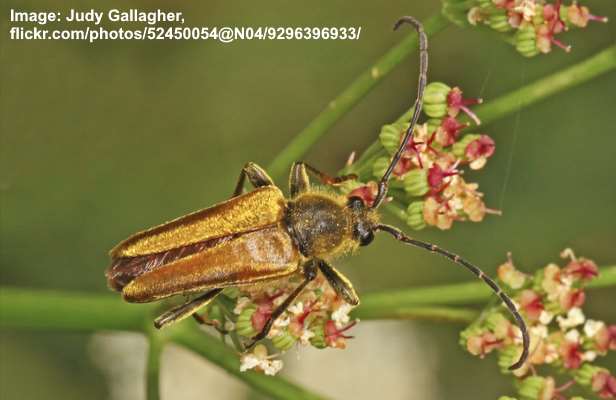
The golden yellow velvet beetle has a long slightly fuzzy body with long legs and antennae
Also called the golden flower longhorn, the dark yellow velvet beetle is a native beetle in North America. The large yellow beetle has a strongly tapered body, giving it a triangular appearance. The furry brown thorax is bell-shaped, and its small head has two large black eyes.
The yellow velvet beetle has an easily recognizable shape due to its broad elytra at the thorax that tapers to the rear end. Being a type of longhorn beetle, the golden yellow insect has long, curving black thread-like antennae with yellow bands. Additionally, the beetle is covered in fine yellowish hairs making it look slightly fuzzy.
The yellow velvet beetle measures 0.39” to 0.78” (10 – 20 mm) long. Common to all longhorn beetles, this species also has long legs, especially the two rear legs.
This type of flower beetle is often found feeding on flower nectar and pollen in the summer. Due to the beetle’s furry coating, it is also an excellent pollinator in gardens and parklands of North America.
Yellow beetle identification
The yellow velvet beetle is identified by its golden yellow elytra, which are covered in fine hairs. Other characteristics of the beetle include curved, thread-like antennae, long legs, and a triangular-shaped body.
Yellow Soldier Beetles (Cantharidae)
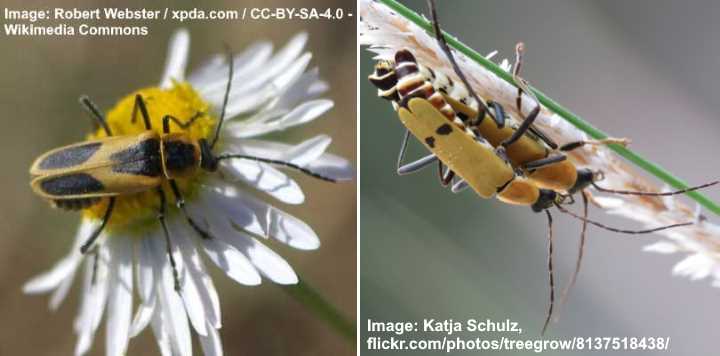
Yellow soldier beetles: Texas soldier beetle (left) and yellow soldier beetles mating (right)
Several species of soldier beetles have yellowish or orangey-yellow elongated elytra that have a flattened appearance. Soldier beetles are relatively slender creatures with oval wing covers, a round thorax, and a small head. They also have long, thread-like black antennae and long skinny legs.
Here are two types of yellow soldier beetles common in North America:
Texas soldier beetle (Chauliognathus scutellaris): The flower-feeding beetle has dull yellowish wing covers with large black markings. The thorax is also dark yellow with a black patch in the middle. It has a black head and slender, thread-like antennae.
Yellow soldier beetle (Chauliognathus misellus): This slender yellowish-orange beetle has a solitary black spot on each wing cover. Its thorax is orange, and it has a black head. Some species of these beetles are also bright yellow.
Yellow beetle identification
Yellow soldier beetles are identified by their elongated body with distinctive rounded thorax, long antennae, and spindly legs.
Goldsmith Beetle (Cotalpa lanigera)
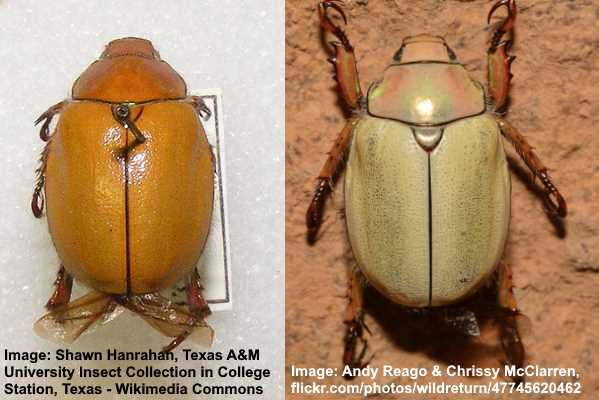
The yellow goldsmith beetle has some color variations and is active at nighttime
The goldsmith beetle is a stout, oval-shaped beetle with a yellowish brown or pale-yellow elytra. This large beetle is without any distinctive markings or patterns on its body. Pictures of the yellow beetle show that the elytra are slightly pitted and a lighter color than the head and thorax.
Large, rounded goldsmith beetles measure 0.74” to 1.02” (19 – 26 mm) long. You will often find the beetles feeding on tree leaves like silver maple, pear, willow, hickory, or poplar. However, they are difficult to spot because the nocturnal beetles are only active at nighttime.
Some color variations are also recognized, with some beetles having pale greenish elytra, brown spiny legs, and an iridescent head and thorax.
Yellow beetle identification
The goldsmith beetle is a large yellowish oval beetle with a rounded body and short brown legs with a spiny appearance.
Christmas Beetle (Anoplognathus pallidicollis)
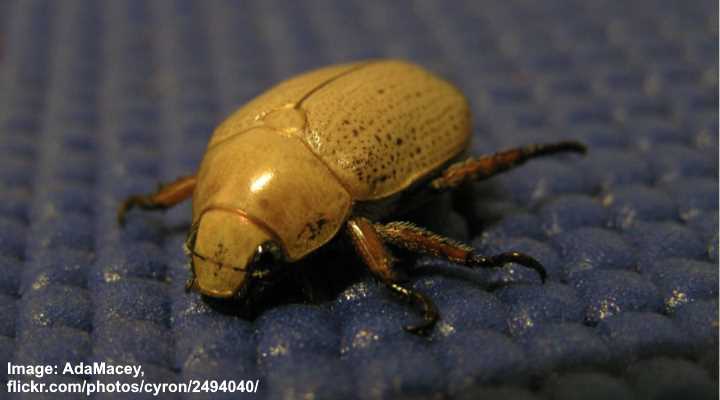
The large yellow Christmas beetle tends to feed on eucalyptus trees
The Christmas beetle is a large type of scarab beetle with a smooth, shiny body and a dull golden yellow color. Identifying features of this yellow beetle include rows of punctuations on its back, dark brown and black legs, and two large conspicuous eyes on the side of its downward-facing head.
Christmas beetles are native to Australia, where they are active during summer — around Christmas time in the southern hemisphere. The yellowish flying beetles measure 0.78” 1.18” (20 – 30 mm) long, making them one of the largest species of yellow beetle.
Once the adult beetles emerge from the soil, they tend to feed on eucalyptus plants. Their voracious appetite can cause them to defoliate trees in a short time, especially if there is a large number of the yellow bugs. The beetles are usually active just after sunset and are attracted to lights when it’s dark.
Yellow beetle identification
Christmas beetles have a distinct glossy brownish-yellow color, with some species having iridescence colors on their head and thorax.
Wasp beetle (Clytus arietis)

The black and yellow wasp beetle has a slender body and is an important pollinator
The wasp beetle is a striking black and yellow insect, classified as a ‘wasp-mimicking’ beetle. The wasp-like arthropod has a slender black body with bands and markings of bright yellow. Additionally, there are two narrow yellow lines across its thorax. Also, fine yellowish hairs cover the beetle, giving a fuzzy appearance.
The wasp beetle is a type of longhorn beetle with characteristic curved, thread-like brown and black antennae. Like other longhorns, the beetle has long legs, with the hind legs being noticeably longer.
Wasp beetles measure 0.35” to 0.71” (9 – 18 mm) long. Despite looking like wasps, the flying black and yellow insects are entirely harmless. However, they feed on flower pollen and nectar during summer, making them important pollinators.
Yellow beetle identification
The wasp beetle is a slender black and yellow creature that looks like a wasp. Its characteristic features are bright yellow markings on a jet-black body. It’s easy to mistake the flying beetles for wasps.
Related articles:
- Red Beetles – Identification Guide
- Small Brown Beetles (In the House and Outside)
- Black Beetles – Identification
